FOTA Update | Firmware Over the Air
Delivering wireless updates for your IoT Devices
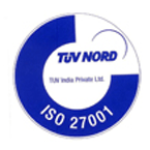
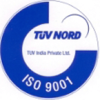




FOTA update is necessary to ensure secure and robust operations of remote devices in Industry 4.0, automotive, and healthcare domains.
Embitel’s IoT engineering teams develop FOTA Update solutions for embedded IoT devices, enabling real-time updates, improving performance, and enhancing security—anywhere, anytime.
Features of Our FOTA Update Solution for Remote Device Management

- Remote device management through OTA software updates
- Scheduling, release and reporting of the firmware build versions through a web server interface solution

- Controlled and customized OTA software release management, through logical device grouping based on project requirements

- Controlled and customized OTA software release management, through logical device grouping based on project requirements

- Ensuring that device downtime is minimized during updates

- Ensuring that every session of FOTA update is complete and atomic; so that the firmware update does not end in an incomplete/broken state
Types of FOTA Update Offerings at Embitel
Firmware Over the Air – Design and Development Services
- Flash Memory Selection – NOT, NAND & more, based on your project requirements.
- Integration of Wi-Fi/Bluetooth/GPRS/GSM modules for secure communication between the FOTA server and the target devices.
- Design and development of Firmware and integration with IoT protocols such as MQTT, CoAP; HTTPS & SSL for secure data exchange; FTP/FTPS for file transfer.
- Selection of specific encryption methods to check the sanity of the update package.
- Deciding the level of FOTA update required (At the whole system level, OS and application level, or only at the application level).
- Bootloader development to enable firmware download and reprogramming on the application device.
- Design and development of the FOTA management server interface and other GUIs to build/schedule/deploy/manage the update package.
- Design and development of the interface (GUI) to build/schedule/deploy/manage the update package.
- Tracking as well as reporting the successful instances of firmware updates.
- Integration of Firmware Rollback mechanism to mitigate any failure or bug detected during Over the Air update.
- Development of Automated test frameworks to enable devices to perform self-test & send status reports, at the end of an update.
- Power Failure
- Communication Failure
- Memory Corruption
- Failure to boot the new firmware image
- Flashing of a corrupted firmware image
- Failure to retrieve the information about the configuration & last status of the firmware
Embitel’s FOTA Update Stacks – Update Management
Our FOTA Update stacks are designed to compliment the development of your cloud based innovation!
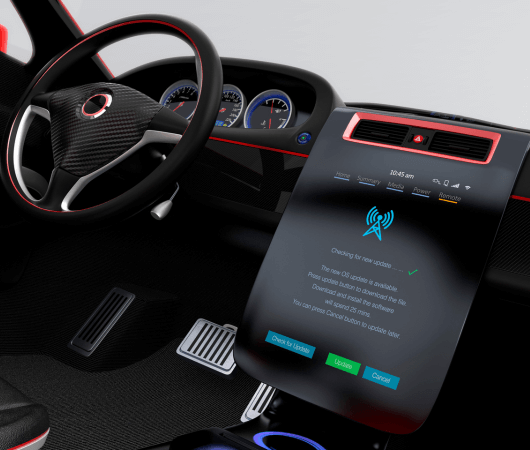
Device Management
Our device management stack conducts operations to deploy FOTA updates to your fleet of IoT devices.
Enhance your device management with Embitel’s FOTA service offerings:
- Seamless Updates: Instantly deploy software and firmware updates across your device fleet.
- Remote Configuration: Adjust settings in real-time without physical access.
- Proactive Monitoring: Monitor device performance and health for proactive maintenance.
- Robust Security: Ensure authorized updates with top-tier security protocols.
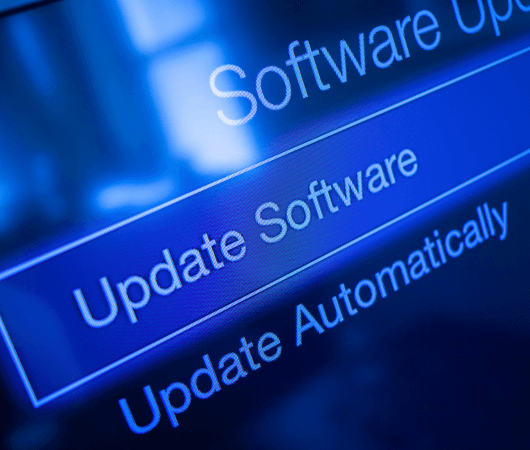
Campaign Management
Optimize your OTA updates with Embitel’s Campaign Management services. Our solution enables you to:
- Plan Updates Strategically: Tailor your update campaigns to meet specific goals and timelines.
- Deliver Updates to the Right Customers: Segment devices for precise targeting, ensuring the right updates reach the right users.
- Real-time Monitoring: Track deployment success and user feedback to optimize updates.

User Management
Embitel’s User Management services - designed for high-volume, multi-tenant environments enables you to have:
- Role-Based Access Control: Efficiently manage users with different roles, ensuring tailored access and permissions.
- Scalable Architecture: Support a large number of users seamlessly, maintaining performance and reliability.
- Centralized Administration: Simplify user management with a single platform for easy monitoring and control.

Cloud Deployment Scripts
Harness the power of Embitel's Cloud Deployment Scripts powered by Terraform for your FOTA updates. Our solution provides:
- Automated Deployments: Ensure consistency and efficiency with infrastructure as code.
- Scalability: Easily scale your updates across multiple environments, adapting to your needs seamlessly.
- Version Control: Manage and track changes with precision, reducing risks and improving reliability.
- Rapid Rollouts: Accelerate your update process with quick and efficient deployments.
Embitel’s OTA Firmware Update Accelerator
Our OTA firmware update accelerator is a stack that helps you fast-forward the development of a FOTA solution. This stack is highly customisable and can be configured based on your needs. Using this stack, you can develop scalable and secure FOTA solutions in half the time!
This is a complete FOTA solution with cloud and device side components, secure connectivity modules and Uptane readiness. Read more about the unbeatable benefits of our OTA firmware update accelerator for your automotive development projects.
The device-side FOTA micro stack can be specifically used by customers for accelerating the development of applications such as digital instrument cluster, infotainment system, and digital cockpit. The stack can easily enable FOTA update features in these applications. Read more about our automotive FOTA micro stack.
Firmware Over the Air – Success Stories

Over the Air Update Integration for Solar Energy Harvesting Platform
Our customer, a leading Independent Power Producer (Clean and Renewable Energy), required the integration of FOTA module for the update of their field gateway devices. Other requirements - Zero downtime and no impact on the operations of the solar energy harvesting deployment during software update.
Embitel Impact:
- Our solution ensured a secure way to update field gateway devices for consistent performance.
- Controlled and scheduled FOTA release mechanism at non-peak hours - to optimise performance

Firmware Over the Air Module for Industrial Battery Monitoring System
Our client had deployed a network of industrial UPS units for their customers. They required an intelligent battery monitoring system that would ease manual efforts and deliver benefits of Predictive Maintenance with FOTA update.
Embitel Impact:
- We deployed a series of automated battery monitoring units connected to an IoT gateway device to reduce the operational cost of manual monitoring.
- If there are changes in the measurement algorithm, the battery monitoring units and gateway devices are updated with the requirements through FOTA.

Integration of Automotive Over the Air Updates for EV Infotainment System
This is the story of how we partnered with multiple electric vehicle manufacturers for the development of Android-based In-Vehicle Infotainment systems. Our product engineering teams successfully integrated FOTA update modules for these IVI systems.
Embitel Impact:
- Reusable components of the FOTA solution (software stack, cloud component, etc.) enabled reduction in development time and cost.
- Integration of FOTA update ensured efficient remote management of application software.
[Video] What Makes Firmware Over the Air (FOTA) an Automotive Superhero?
Components of FOTA Update System
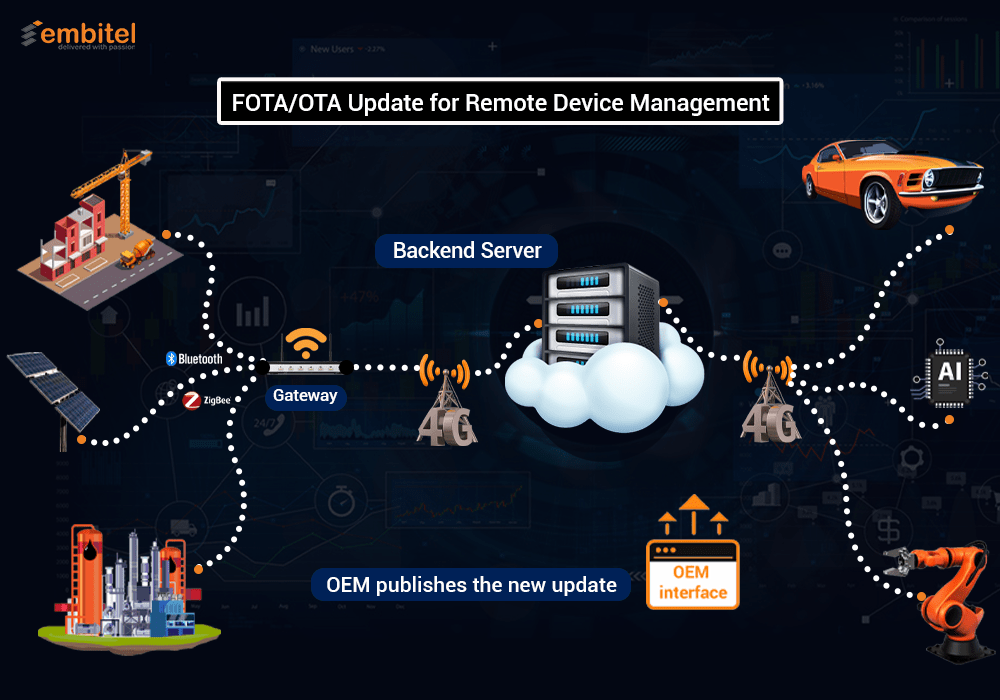
OTA Update for Your Connected System: Business Benefits
- Safeguard your applications against any possible security vulnerability
- Efficient and remote management of your critical work product and site equipment.
- OPTIMIZE DATA COSTS and minimize system downtime by updating numerous changes in one go, over the air.
- Update your firmware in line with your SCALING business.
- Reduce on-field MAINTENANCE COSTS by updating firmware on device, post-deployment
- With FOTA you can do:
- Feature updates
- Functional updates
FAQs Regarding FOTA Update: IoT and Automotive Devices
Ans. This decision regarding the method of firmware flashing will depend on the following factors:
- Number of devices to be updated ( A Gateway device is preferred if the number of deployed target devices is on the higher side)
- The type of communication interfaces available
- The operating environment of the deployed devices
- Desired cost-effectiveness of the FOTA feature
Ans: We had ensured to make security features part of the FOTA solution at the design stage of the SDLC.
Following are the details regarding our FOTA security features:
- Integrated HTTPS & SSL certifications: to ensure Secure data exchange
- Encryption Keys and security certificates for secure communication between server and target devices
- Role based Access Control to avoid any unauthorized data access
- Code Signing: to verify the authenticity and integrity of firmware executables and scripts and to safeguard them against any malicious tampering by unauthorized agents.
Ans: Based on our experience, a subscribe –publish mechanism for FOTA upgrade is ideal for large scale implementations. Additionally, a subscribe –publish mechanism offers following advantages over the Polling mechanism:
- Cost effective
- Minimizes data usage
Reason – field-deployed devices are not required to check for new firmware update every now & then . Any new firmware update package or image that gets published in the server, is notified to the devices as per the schedule.
Polling mechanism is easier to implement but consumes more data.
- Ready to deploy Bootloader Software
- Software components deployed for secure file transfer, update notifications.
- Reusable Algorithms for accurately
- updating the new firmware,
- Identifying the update requirements
- Validating the existing firmware versions
Ans: IoT gateway devices that support firmware OTA flashing on connected devices can belong to one of the following categories:
- Processor and OS based Gateway: preferred for large scale (industrial) deployments. These are easily scalable and depend on application processor and the base OS ( Android/Linux).Cost of such IoT gateway devices is also comparatively higher.
- Microcontroller based Gateways: These are preferred for applications which require specific functionalities like – better device connectivity, reduced memory and power consumption; and involve lower BOM cost.
- Mobile Device as a Gateway: These are preferred when target devices are fewer in number and individually owned.
At Embitel, we have developed IoT gateway devices at various scales and for different application domains, specifically for telematics and industrial automation systems.
Ans: Following are the details regarding our backend server architecture:
- We have deployed Postgress relational database to leverage the following benefits:
- Open Source nature and support for an enterprise-class performance
- Cross platform compatibility ( UNIX, Windows, Native Windows)
- Responsive in high volume environments
- Exhaustive library and framework support
- Full database encryption to ensure security
- Our solution is backed by an Nginx server for file transfer. Our team took this decision based on the following features of an Nginx server:
- Versatile, efficient and light-weight web server
- Easy and simpler installations
- Ideal for serving static files pdf, zip, html, mp4 & others
- Support for high concurrent traffic
- Compatible with commonly-used web apps like WordPress, ruby, python, Joomla, drupal etc.
- We have also leveraged Django framework for developing interfaces for the target devices. The Django framework is known for its scalability, security and ease of execution – features that make it a favorite among the web developers.
Ans: In order to ensure security of backend operations in the server and to avoid unauthorized access of the backend data, we implement:
- Password based authentication control, or
- Certificate based authentication (CA)
Ans.All details related to firmware file and each of the versions (previous and the new) are stored systematically in the tables of the relational database.
The tables would include information such as the file name, the version number, and the action required (upgrade or delete) pertaining to each firmware package.
This ensures accurate version management of the firmware package, which is being deployed in the target devices.
In case a new version of the firmware has a bug or does not meet the desired expectations, there are provisions to roll back to the previous firmware version, using the information in the backend database.
Ans. We use the Nginx server for backend operations which provides robust support for load balancing The NGINX server is an efficient (HTTP) load balancer, suitable for wide range of web applications.
The NGINX server has an event-driven (event as in any communication request) architecture that empowers it to manage thousands of connections within a single process with efficient use of hardware and memory.
Thus, even if the number of connected devices that needs a FOTA upgrade increases post initial-deployment, the NGINX server can easily process their connection request without creating traffic spikes.
Ans. Our experienced solution development is a vibrant bunch of Industrial Automation and Automotive domain experts, with the following core skill-sets:
Expertise in IoT communication protocols (MQTT, CoAP, HTTPS)
Testing and validation expertise
Experience in Bootloader Software Development
Know-how and hands-on in system security best practices
Knowledge bytes
- How do I update an IoT device?
- Gateway-to-Cloud FOTA Update – A group of devices are connected to an IoT gateway. The FOTA update is sent to the gateway that is connected to the internet. The firmware on the individual devices do not undergo any changes, and only the gateway is updated with the new firmware. This is more commonly seen in use cases where the IoT devices are not internet-enabled and do not have too much computing power. In such cases, the individual devices are also protected from the internet by the gateway.
- Edge-to-Gateway-to-Cloud FOTA Update – In this method, the firmware on the individual IoT devices connected to the gateway are updated. However, the gateway itself may not be updated with new firmware at that point of time. The IoT devices in these use cases have enough computing capabilities and can perform the FOTA update without the need for internet connectivity.
- Edge-to-Cloud FOTA Update – This method of FOTA update is more prevalent in consumer IoT devices as they are in the proximity of WiFi signals at small commercial buildings or homes. The device receives the updates directly from a remote server through the Internet and the updates are installed.
- What is
- What is the need for software updates on a car?
The reasons are many. Some of the most common needs are mentioned below:
- A software update reformats the vehicle’s ECU and hence, rectifies factory software issues that may be causing some inconvenience to the driver.
- When auto manufacturers identify opportunities to improve the efficiency or durability of the car’s ECU, they deploy FOTA updates to implement these firmware changes.
- FOTA update can also rectify latent safety issues that were not accounted for in the factory software.
- How is FOTA installation done?
- New update or the new version of the software/firmware is made available in the cloud server by the device owners.
- The latest firmware update is downloaded and made available to the network of the IoT or automotive devices (For e.g., a Vehicle Telematics system in a car or an IoT enabled equipment in a manufacturing plant).
- The FOTA server stores all the information related to the devices in the network such as the current status and the existing version of the firmware in use, within a large database.
- The server also manages the process of sending the firmware to the target application as and when it is published or based on a schedule. The FOTA server identifies any bug in the firmware and reports it as well.
- The end devices or the applications pull the upgrades from the FOTA server based on either the subscribe-publish mechanism or a polling mechanism over a secure wireless (Wi-Fi/ BLE) connection.
- The firmware is then installed in the end-user application with the help of a bootloader.


